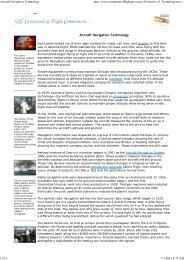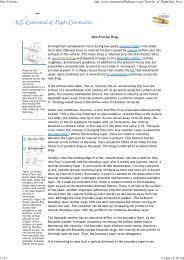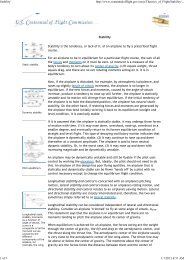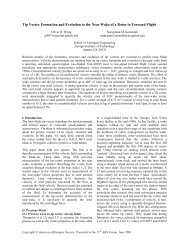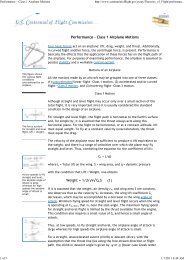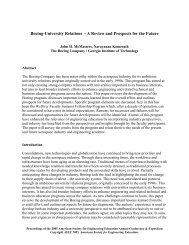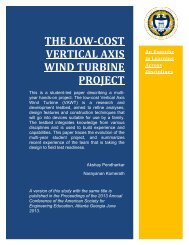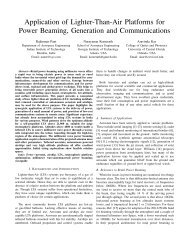Unsteady Aerodynamics of Rotorcraft in Ground Effect - Aerospace ...
Unsteady Aerodynamics of Rotorcraft in Ground Effect - Aerospace ...
Unsteady Aerodynamics of Rotorcraft in Ground Effect - Aerospace ...
Create successful ePaper yourself
Turn your PDF publications into a flip-book with our unique Google optimized e-Paper software.
3. Unstead<strong>in</strong>ess Seen <strong>in</strong> Flow Visualization<br />
In order to compare the unstead<strong>in</strong>ess <strong>of</strong> IGE case and that <strong>of</strong> OGE case, movements <strong>of</strong> tip vortices were<br />
analyzed by look<strong>in</strong>g at the tip vortex location variation at different times captured by us<strong>in</strong>g a video camera. The<br />
results are summarized <strong>in</strong> Table 2. From the table, it can be seen that the IGE case is much more unsteady than the<br />
OGE case. The peak-to-peak jitter for the IGE case is almost double that <strong>of</strong> the OGE case. However, the difference<br />
<strong>in</strong> standard deviation is negligible, imply<strong>in</strong>g that the jitter <strong>in</strong> both cases is similar except for the occasional sharp<br />
change <strong>in</strong> tip vortex position <strong>in</strong> the IGE case.<br />
Table 2: Tip vortex location variation (IGE/OGE, y/r = 0, µ=0.03)<br />
IGE<br />
OGE<br />
x z x z<br />
Max peak to peak variation 0.048r 0.034r 0.032r 0.019r<br />
Standard deviation 0.012r 0.011r 0.011r 0.008r<br />
Measurement uncerta<strong>in</strong>ty 0.010r 0.010r 0.006r 0.006r<br />
x: Horizontal direction<br />
z: Vertical direction<br />
r: Rotor radius<br />
B. Hot-wire Measurement (IGE/OGE)<br />
The most notable result was the difference <strong>in</strong> the fluctuations <strong>in</strong> the <strong>in</strong>flow velocities obta<strong>in</strong>ed from the<br />
hotwire measurements. As was expected, the <strong>in</strong>flow magnitude was lesser for the IGE case. However, the magnitude<br />
<strong>of</strong> fluctuations was negligible <strong>in</strong> the OGE case, while it was about 5 to 10 % <strong>in</strong> the IGE case, and is shown <strong>in</strong> Fig. 8.<br />
The upper and lower bounds are marked <strong>in</strong> red and green respectively, and represent twice the standard deviation.<br />
Also it has to be noted that the IGE case appears to have spikes that seem to re-occur every second. This appears to<br />
be the effect <strong>of</strong> the recirculation <strong>of</strong> the tip vortices.<br />
To get a better idea <strong>of</strong> the frequency <strong>of</strong> these fluctuations, a Fourier analysis was done to the velocity time<br />
trace. The results are shown <strong>in</strong> Fig. 9. It can be seen that the 2 per rev component dom<strong>in</strong>ates the flow out <strong>of</strong> ground<br />
effect. However, with the ground plane, the spectrum is dom<strong>in</strong>ated by low frequency components. It can be seen that<br />
there is a dist<strong>in</strong>ct difference between the low frequency components <strong>in</strong> the IGE and the OGE case. In fact, the peak<br />
frequency <strong>in</strong> the IGE case occurs at about 1 Hz, even overshadow<strong>in</strong>g the 2 per rev spike, which is dom<strong>in</strong>ant <strong>in</strong> the<br />
OGE case. This difference can be seen <strong>in</strong> Fig.9, which shows the Fourier coefficients for the two cases at advance<br />
ratios <strong>of</strong> 0.03, 0.04 and 0.05.<br />
The results <strong>of</strong> the hotwire measurements close to the ground vortex are plotted <strong>in</strong> Fig. 10. It can be seen<br />
that at po<strong>in</strong>t A, a velocity fluctuation at low frequency (1 to 2 Hz) occurs and appears to be related to the movement<br />
<strong>of</strong> the flow separation po<strong>in</strong>t ahead <strong>of</strong> the nascent ground vortex. This correlates with the flow visualization results at<br />
an advance ratio <strong>of</strong> 0.05 where the flow appeared to switch between recirculation and the prelim<strong>in</strong>ary stage <strong>of</strong><br />
formation <strong>of</strong> a ground vortex. At both po<strong>in</strong>ts C and E, the frequency <strong>of</strong> the velocity fluctuation became relatively<br />
broad-band (between 0 and 50Hz). The mean flow velocities at these po<strong>in</strong>ts were higher than free stream speed,<br />
which is approximately 16.5fps at an advance ratio <strong>of</strong> 0.05. At po<strong>in</strong>t G, a low frequency velocity fluctuation occurs.<br />
However, it is not similar to the large velocity separation-like change that occurs at po<strong>in</strong>t A, and appears to be<br />
<strong>in</strong>duced by the passage <strong>of</strong> the tip vortex.<br />
The isolated-rotor experiments above served to establish that<br />
1. we could <strong>in</strong>deed achieve clean periodic flow conditions <strong>in</strong> the absence <strong>of</strong> ground effect<br />
2. that the rise <strong>in</strong> unstead<strong>in</strong>ess due to ground effect was clearly perceptible and quantifiable<br />
3. that wake <strong>in</strong>teraction with the ground does cause unstead<strong>in</strong>ess <strong>in</strong> the ground vortex.<br />
4. that recirculation <strong>of</strong> vortices does cause fluctuations <strong>in</strong> the rotor <strong>in</strong>flow plane.<br />
5. long-period unstead<strong>in</strong>ess is <strong>in</strong>deed seen <strong>in</strong> the flowfield<br />
The new work for this paper focused on observations with a fuselage present <strong>in</strong> the flowfield. This is essential<br />
to (eventually) relate flowfield observations with pilot experience <strong>of</strong> stick forces and moments. These measurements<br />
would help <strong>in</strong> quantify<strong>in</strong>g the fuselage loads decoupled from the rotor hub moments.<br />
C. Fuselage Side Force Measurements<br />
- 4 -<br />
American Institute <strong>of</strong> Aeronautics and Astronautics



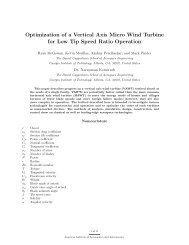
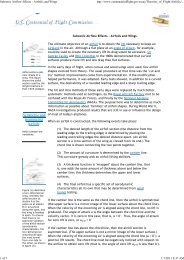

![p density of fluid, kg/m3 [Greek letter rho] V mean velocity of fluid, m ...](https://img.yumpu.com/50595898/1/184x260/p-density-of-fluid-kg-m3-greek-letter-rho-v-mean-velocity-of-fluid-m-.jpg?quality=85)
